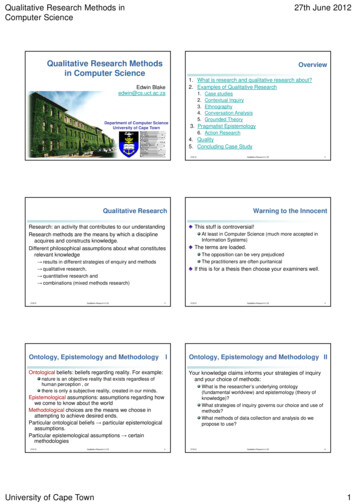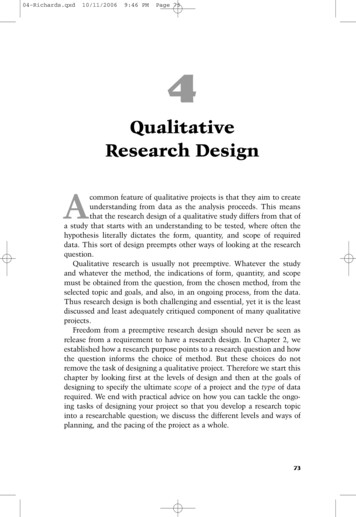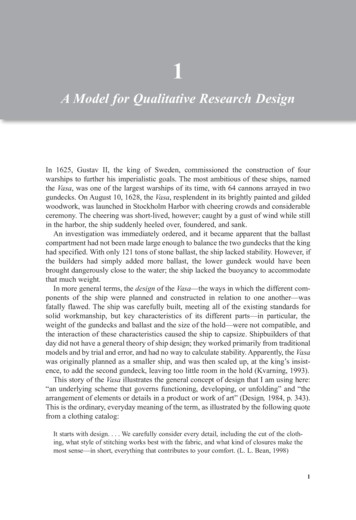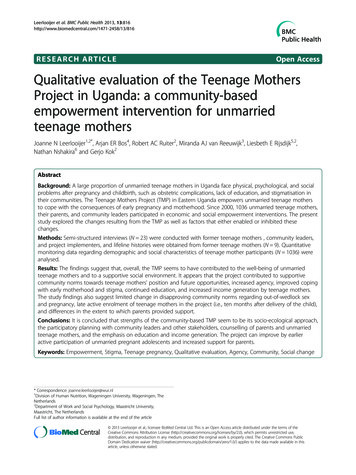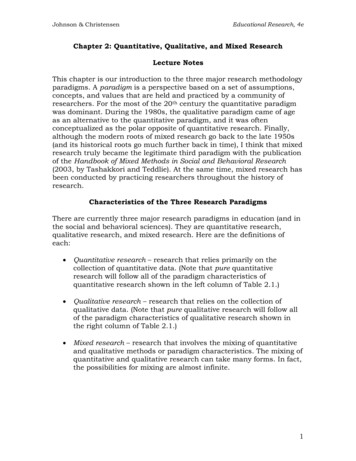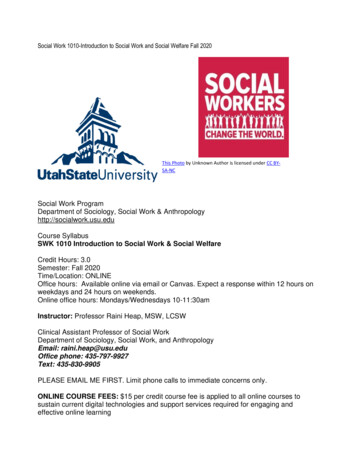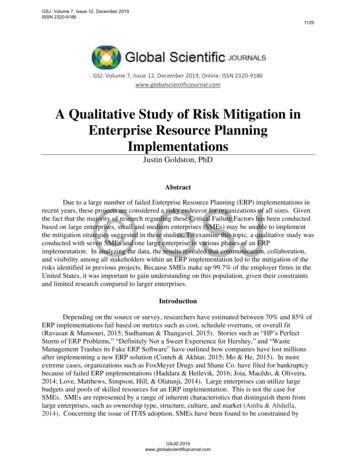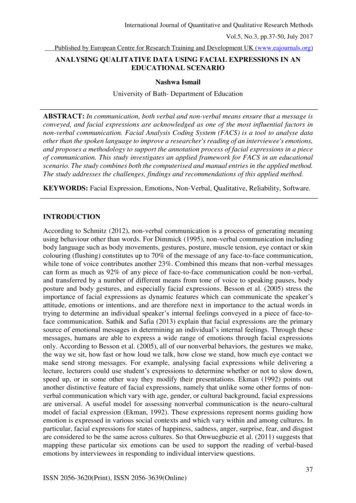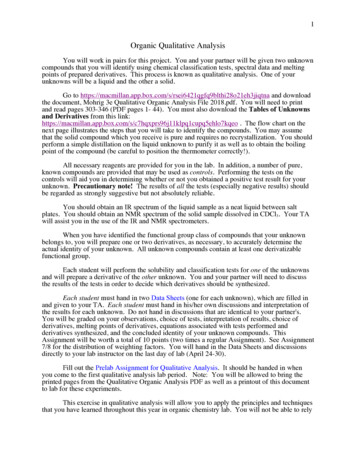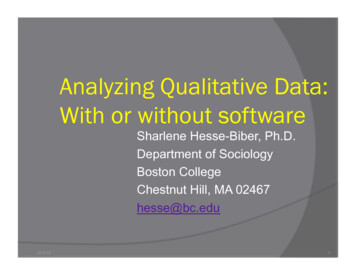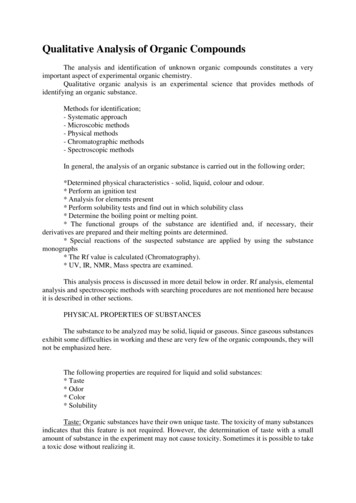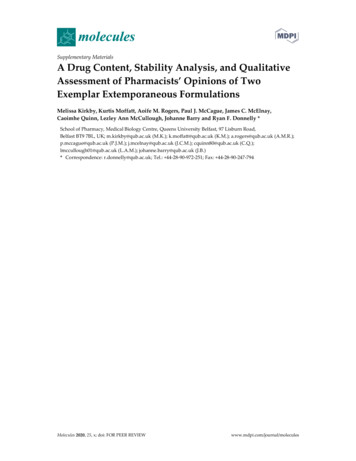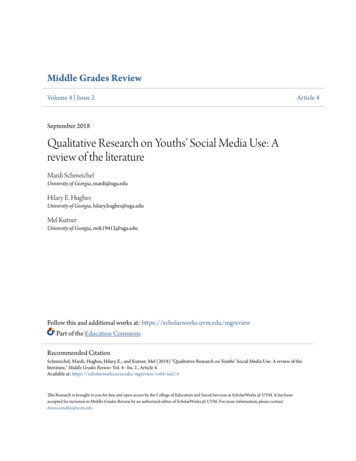
Transcription
Middle Grades ReviewVolume 4 Issue 2Article 4September 2018Qualitative Research on Youths’ Social Media Use: Areview of the literatureMardi SchmeichelUniversity of Georgia, mardi@uga.eduHilary E. HughesUniversity of Georgia, hilary.hughes@uga.eduMel KutnerUniversity of Georgia, mrk19412@uga.eduFollow this and additional works at: https://scholarworks.uvm.edu/mgreviewPart of the Education CommonsRecommended CitationSchmeichel, Mardi; Hughes, Hilary E.; and Kutner, Mel (2018) "Qualitative Research on Youths’ Social Media Use: A review of theliterature," Middle Grades Review: Vol. 4 : Iss. 2 , Article 4.Available at: his Research is brought to you for free and open access by the College of Education and Social Services at ScholarWorks @ UVM. It has beenaccepted for inclusion in Middle Grades Review by an authorized editor of ScholarWorks @ UVM. For more information, please contactdonna.omalley@uvm.edu.
Schmeichel et al.: Qualitative Research on Youths' Social Media UseQualitative Research on Youths’ Social Media Use: A Review of the LiteratureMardi Schmeichel, University of GeorgiaHilary E. Hughes, University of GeorgiaMel Kutner, University of GeorgiaAbstractIn this article we explore how educational researchers report empirical qualitative research about youngpeople’s social media use. We frame the overall study with an understanding that social media sitescontribute to the production of neoliberal subjects, and we draw on Foucauldian discourse theories andthe understanding that how researchers explain topics and concepts produces particular ways of thinkingabout the world while excluding others. Findings include that: 1) there is an absence of attention to thestructure and function of social media platforms; 2) adolescents are positioned in problematic,developmental ways; and 3) the over-representation of girls and young women in these studiescontributes to the feminization of problems on social media. We conclude by calling for future researchthat can serve as a robust resource for exploring adolescents’ social media use in more productive,nuanced ways.INTRODUCTIONThe life of social media platforms has beenrelatively short, but attention to this domain oftechnology and its impact on youth and youthculture is at the forefront of scholars’ researchagendas across multiple disciplines.Additionally, there has been a constant stream ofadvice, concern, and reporting about youths’social media practices in popular culturediscourses (e.g., Dunkley, 2017; Heitner, 2017;Mastroianni, 2016; Whitson, 2017). Based onfindings from two of the authors’ previous workon social media (Author 1, Author 2), we beganpreparing for a qualitative study to explore howand why youth engage with social media and theconsequences of those practices for youth andfor society.The research presented in this articlegerminated from our initial literature review ofthe existing research on young people’s socialmedia use. We were surprised both by what wefound, and even more, what we did not find inthe literature. We realized from the start, forexample, that there were considerably morequantitative research studies than qualitativestudies. Perhaps more importantly, we foundthat within the qualitative research literature,there was not a coherent pattern in the wayresearchers described adolescents’ social mediause. By this we mean that there was not aconsistent set of behaviors, conditions, orPublished by ScholarWorks @ UVM, 2018contexts described in these studies. The conceptof what social media use “is” was operationalizedin a wide variety of ways, and perhaps as aresult, the study designs and the social mediabehaviors captured and analyzed varied widely.Further, the social media literature citations thatauthors used to situate the studies wereinconsistent, in the sense that they did not traceback to a set of foundational texts. Overall, thequalitative literature in which the studies weregrounded reflected a disparate set of ideas,purposes, and theories.While a great deal of attention is paid to youths’engagement with popular media, we wonderedwhat the pattern of divergent studies we foundmight mean for other academics and educatorswho turn to research to explore and understandthis phenomenon. These concerns led us topostpone our current study in order to firstconduct an analytical review of the qualitativeresearch that attends to youths’ social media use.After describing our theoretical framework andmethodological processes below, we presentthree salient findings from our analysis thatreflect the ways in which the neoliberal framingof youth and a constrained understanding ofsocial media are reproduced through thisliterature. We then discuss suggestedconsiderations for future research focusing onyouths’ social media use.1
Middle Grades Review, Vol. 4, Iss. 2 [2018], Art. 4Theoretical FrameworksWe frame the overall study with anunderstanding that social media sites contributeto the production of neoliberal subjects. Thiscritical perspective of social media as atechnology of neoliberalism relies heavily onmedia studies theorists (e.g., Gill, 2007, 2008,2016; McRobbie, 2009) who foregroundneoliberalism as a factor shaping media uses.Within this work, neoliberalism is understood asa discursive and material force that extends thelogic of the market to aspects of social lifepreviously not subjected to economic rationales(Foucault, 2008). In other words,entrepreneurial motivations are understood toextend to all conduct and “interpellateindividuals as entrepreneurial actors in everysphere of life” (Brown, 2005, p. 42). In thissense, a wide variety of human behavior,including social media use, is seen to be drivenby interests and rationales informed byeconomic concepts, like “value”, “efficiency”, and“branding.” Research drawing on analyses of theintersection of neoliberalism and social mediaoffers valuable tools to examine the causes andconsequences of the introduction and explosionof social media technologies over the last severaldecades.Within this larger neoliberal framing of thestudy, we also drew on Foucauldian discoursetheories and the understanding that howresearchers explain topics and conceptsproduces particular ways of thinking about theworld while excluding others. As Mills (2004)describes, Foucauldian-influenced researchpositions “discourse as something whichproduces something else (an utterance, aconcept, and effect), rather than somethingwhich exists in and of itself” (p. 15). Specifically,language contributes to the production ofdiscursive structures which “have effects onways of thinking and behaving” (Mills, 2004, p.15). As such, the productive power of languagedoes not lie within the meaning of the words, butthrough the potential of language to plug intosystems of understanding that produce meaning,form subjects, and regulate conduct (MacLure,2003). In other words, the language we use asqualitative researchers to situate our work andframe our findings does not stay bound withinthe published document; rather, it contributes toalready existing discourses that produceparticular understandings and obscure iss2/4Taking up this Foucauldian concept regardingdiscourse, we sought to understand how thelanguage researchers use contributes to themaintenance of particular discourses throughthe continual citation of particular versions ofmeaning and understandings. Our analyses ofthe research literature involved paying closeattention to the language used to describe socialmedia and youth in order to trace the discoursespresent in the discussions. In doing so, weexplored how these descriptions might shapereaders’ perceptions of youths’ social mediapractices, and how they might limit the ways inwhich young people’s social media behaviorswere framed in the literature. In the analysisthat follows, we describe patterns in the datathat described youths’ social media behaviors incertain ways, and not others, and consider howthese themes might contribute to shaping ideasof what is “normal” and “common sense” aboutyoung people’s social media use.Data CollectionOur research team began by searching for peerreviewed research focusing on social media andyouth in four education databases: EducationResearch Complete, Educational AdministrationAbstracts, ERIC, and PsycINFO. We used severalfilters to shape our initial search. First, welimited the search to articles published since2007 to focus on social media platforms that arein current use (e.g., Facebook, Instagram,Snapchat, etc.). Further, we used age specificdescriptors (e.g., “youth,” “tweens,”“adolescents,” “middle school students,” “highschool students”) to identify research targetingour focus on youth. Finally, we eliminated nonpeer reviewed research and articles notpublished in English. This initial search yielded744 results.We then undertook four rounds of review. In thefirst round, our goal was to identify studies thatused qualitative research methods and focusedon adolescents. As qualitative researchers ineducation concerned with how adolescents areconstructed and constrained in popular culturediscourses and research literature, our primaryinterest was in analyzing how other qualitativeresearchers were framing studies of youngpeople’s use of social media in educationjournals. At least one member of the researchteam read each abstract to determine themethodology and identify the age ofparticipants. Studies with a primary focus onyoung children (under the age of 10) and those2
Schmeichel et al.: Qualitative Research on Youths' Social Media Usefocused on adults (over the age of 24) were alsodeemed out of scope. The review of the researchmethodology and age resulted in large numberof exclusions and reduced the number of articlesto 67.(1) lack of attention to platforms and theirarchitecture; (2) problematic positioning ofadolescents; and (3) feminization of socialmedia.ResultsIn our next round of analysis, deep reading andrereading of research questions andmethodologies within these 67 articles revealedthat even in studies where researchers collectedqualitative data directly from young people'sexperiences, the focus was typically on howadults might intervene in youths’ social mediapractices. Many articles, for example, focused onhealth promotion studies and descriptions ofhow to use social media in pedagogical ways,which pointed mostly to how adults could usesocial media for their own purposes--rather thanfocusing on how youth were engaging with socialmedia. Studies such as these were excluded.Further, we chose to exclude studies that basedtheir data collection and analysis of generaltechnology use (e.g., amount of time spentonline or on cell phones) rather than describingthe use specific social media applications indetail. While most of the studies describinggeneral technology use did acknowledge one ormore social media platforms, they were excludedif attention to specific platforms was not integralto the analysis. For similar reasons, a handful ofstudies on MySpace and YouTube were excludedbecause the former is largely not used by youngpeople today and the latter does not functionprimarily for social networking. Thus, the finalsample included 16 articles published in 11journals between 2013 and 2016 (see AppendixA). While this made for a manageable number ofarticles to review, it also indicates thatqualitative research on how adolescents makemeaning with popular social media platforms issparse.The Role of Social Media PlatformsIn our third and fourth rounds of review, at leasttwo members of the research team reviewedeach article. Our specific focus at this stage ofthe analysis was to document the discursivepatterns used to describe the ways young peopleengage in meaning making with their socialmedia use and to consider how neoliberalconcepts and themes were deployed inresearchers’ descriptions (see Appendix B).Following each of these rounds, the researchteam met to discuss emerging patterns and waysof characterizing the data in relation to howadolescents and social media were beingproduced in certain ways and not in others. Inthe following sections we present three findings:Published by ScholarWorks @ UVM, 2018The ways in which researchers situate andcontextualize youths’ social media use as aproductive topic, or as a “problem” in need ofinvestigation, provides great insight into the waythat both youth and social media activities areframed in the discourse. In order to determinethe ways that researchers were framing socialmedia use as worthy of study, we identified therationale for attention to the topic in eacharticle. The justification for researching youthfocused social media use typically appeared ininitial sentences or opening paragraphs of eacharticle. The systematic analysis of theserationales revealed that the inevitability of socialmedia use was the most common justificationfor researching the topic. By this we mean thatmost researchers described the role of socialmedia in the lives of adolescents as a reality thathas simply emerged and now needs to beexplored. Excerpts like the following exemplifythe kinds of rationales found in the initial pagesof a majority of the articles:Young adults spend more time withtechnology than any other daily activity.(Vaterlaus, Barnett, Roche, & Young, 2016,p. 596)Young people are the fastest growingadopters of new online platforms, withnearly a quarter of teens reporting beingonline ‘almost constantly’. (Malvini Redden& Way, 2017, p. 21)Social networking sites have become centralto the way young people communicate intheir everyday lives. (Rubin & McClelland,2015, p. 512)These descriptions of the ubiquity of socialmedia use among adolescents frame thisphenomenon in an ahistorical and uncriticalmanner. Positioning the emergence of socialmedia use as a dominant activity in youngpeople’s lives – as if it is a behavior and practicethat has come from nowhere – makes it difficultto trace its history to a pattern of behaviorassociated with specific discourses andideologies. In particular, this matter-of-fact, “we3
Middle Grades Review, Vol. 4, Iss. 2 [2018], Art. 4just have to deal with it” way of describingadolescent media use unmoors it from theconsideration of the growth of digital technologyas one tentacle of the broader neoliberal forcesshaping society, economics, and politics.The perspective that our role as researchers is torespond to the new reality of social media ispervasive in this literature. Take, for example,these justifications found in the opening pages oftwo different studies:We find ourselves in a world where socialnetworking media are integral to the waypeople interact. This is particularly the casefor teenagers, who rely on social networkingsites such as Facebook to communicate withfriends, establish new friendships, and findexpression through posting online[emphasis added]. (Price, Wardman, Bruce,& Millward, 2016, p. 162)Given the increasing use of the Internet andsocial media by children, tweens, and teens,privacy has emerged as an urgent topic ofconcern among parents, educators, andpolicymakers [emphasis added]. (Davis &James, 2013, p. 5)When adolescents’ use of social media is framedas a “given” reality in which we “find ourselves,”the emergence and function of social mediaplatforms as corporate, profit making spaces,working to monitor and shape the behavior ofneoliberal subjects in specific ways, areobscured. This approach conceals the materialmanifestations of the intentional design of theseplatforms, which are intended to capture andmaintain attention through, for example, avariable reward structure (e.g., checking for“likes” and “retweets”) that keep users engagedand online (Alter, 2017). This design is drivenby corporate consumer interests and work toaffect a particular consumer behavior. As Masonand Metzger (2012) assert, while the ways inwhich participants interact in digital spaces “areheavily mediated by the commercial productsand services of multinational corporations [,] thecitizen’s role mainly appears to be to adjust tothese new realities and make consumer choices”(p. 442). When social media research fails totake corporatism into account, the function ofthese platforms as commercial products isignored and the need for people to adjust to thisnew reality is unquestioned. Even more,research that positions adolescents’ social mediause as taken-for-granted is likely to 4/iss2/4these systems and processes as they are. Theunquestioned status of social media use in youngpeople’s lives as a “given” makes it difficult toimagine how it could be otherwise.Taking platforms into account. Theunderlying assumption in these justifications –that we should research social media usebecause everyone is using it – is that technologyuse is an independent force for which no one isresponsible. What this assumption obscures, asEgea (2014) asserted, is that our digital lives arecontributing to a “new modality of socialengineering [that] positions human beings andknowledge as management resources exploitedto obtain exchangeable and marketable value”(p. 268). Obscuring the way this re-engineeringis at work, by failing to acknowledge or considerthe way social media is acting upon us, is amissed opportunity. There is great potential inqualitative research on youths’ social media useto attend to the ways social media positionsadolescents as having “exchangeable andmarketable value.” For example, attending to thedesign of platforms in the analysis mightacknowledge that the design of social mediaplatforms drives users to pursue “likes,” whichnot only shapes how people interact on theplatform, but is used as a metric through whichto assess ourselves and others. Attending to theplatform can also highlight the ways that youthnegotiate and manipulate platform architectureto participate in social media on their ownterms. This kind of analysis was present inMarwick and boyd’s (2014a) study through theirexamination of the ways that participants usedthe existing structures of Facebook privacysettings to their advantage. For example, theydescribed the activities of a participant, a wardof the state, who discovered that by activatingher account at night and deactivating it againduring the day, she could avoid surveillance ofthe agencies who were using social media tomonitor her. She used deactivation andreactivation functions available on the platformto avoid detection by adults whom she perceivedwould only be checking her Facebook statusduring the day. This is an explicit example ofincorporating the architecture of the platformsinto the analysis of the phenomenon understudy. In contrast, the rest of the studies in thedata set discussed participants’ interactions inways that ultimately situated the platformsthemselves as neutral vehicles for thephenomena under study. For example, in a studyof gifted and talented girls, participantsmentioned Facebook functions such as tagging,4
Schmeichel et al.: Qualitative Research on Youths' Social Media Usefriending, and self-editing in their descriptionsof their experiences on and with the platform.While the authors acknowledge these aspects ofFacebook, the functions themselves, were notexamined in relation to the participants’experiences as Facebook users or the “layer ofcomplexity” Facebook use has added to theirlives (Price et al., 2013, p. 172). The authorsindicate that one of the themes in their analysiswas that “Facebook draws out a range ofconflicting emotions, anxieties, and attitudes”(Price et al., 2013, p. 168), but they do notdirectly explore, address, or question the waythat Facebook produces these affectiveresponses. For example, they do not unpackparticipants’ perceptions of the importance ofreceiving “likes” or their efforts to curate theirFacebook posts and friend lists to secure asmany positive post responses as possible.Presenting a running count of “likes” and friendtotals are just two aspects of Facebook’sarchitecture that explicitly encourage users tomeasure themselves against their peers. Theseneoliberal functions, and the comparisons andself-evaluations they encourage, likelycontribute to the “sense of loneliness” (Price etal., 2013, p. 171), the participants described.However, when the consequences of particularfeatures of Facebook’s structure andfunctionality remain unexamined andunquestioned, the focus relies solely upon howthe participants react to its features.When trying to make sense of how adolescentsare interacting online, ignoring platformarchitecture seems problematic. Research thatignores the design of the platform obscures theneoliberal functionality of sites like Twitter,Facebook, and Instagram, and the ways thesefor-profit products are shaping our behavior andour sense of self. Perhaps even more troubling,ignoring platform functions produces individualparticipants who are perceived asentrepreneurial, self-optimizing subjects while“effac[ing] power and displac[ing] it ontoseemingly neutral and impersonal systems”(Gill, in press, p. 4). The social engineeringhappening within the platforms is hidden whendescriptions of participants’ use fail to take intoaccount how social media is shaping and guidingusers to interact and respond to each other inways that encourage neoliberal behaviors likecompetition, self-quantification, and selfsurveillance.Published by ScholarWorks @ UVM, 2018The Impetus for Studying YouthAnother pattern we found in our analysis wasthe use of developmental psychology andstereotypical “common sense” assumptionsabout adolescents to describe participants andtheir experiences with social media. Framingyouth through developmental lenses has beenwidely critiqued among scholars over the pastfew decades because of the limited insights theyprovide about young people and their highlynuanced lived experiences. In her work troublinghistorical and cultural conceptions ofadolescence, Nancy Lesko (2012) argues that weneed to recognize that the concept ofadolescence is made – by way of developmentalpsychology – in and through the passage of time,which is signified by age. If we (the authors ofthis paper) say we are interested in researchinvolving youth between the ages of 10 and 20,for instance, this statement might implicitly callforth multiple images and references: developingand/or awkward bodies; strange music;moodiness; distancing; simultaneous laughterand tears; and endless hours on social media,just to name a few (Lesko, 2012). From theperspective of developmental psychology, youthcannot live in the present; they can only exist ina discourse of “growing up” or “alwaysbecoming” (Lesko, 2012; Hughes, 2014; HughesDecatur, 2012; Vagle, 2012). Lesko expands onthis idea:Teenagers are “at the threshold” and in“transition to adulthood.” These phrasessuggest an evolutionary arrival in anenlightened state after a lengthy period ofbackwardness. These phrases alsoparticipate in an “ideology of emergence,”which is a belief that teenagers are naturallyemerging and outside of social influences.They are autonomous beings who getdropped down into various social andhistorical contexts. (p. 2)By paying close attention to how language isused to construct and constrain adolescenTSthen, we begin to see how the concept ofadolescenCE (Vagle, 2014) is positioned asinauspicious, uncontrollable, and naturallyoccurring (Lesko, 2012). We agree with scholarswho find this positioning of youth troublesome,as much of the research over the past fewdecades disrupts developmentalism by adding amore nuanced and thoughtful analysis ofadolescents (see for example, boyd, 2014; Lesko,2012; Vagle, 2012).5
Middle Grades Review, Vol. 4, Iss. 2 [2018], Art. 4In the 16 qualitative studies analyzed, we paidparticular attention to the ways in whichadolescents were described. What we found wasthat many authors wrote with unquestionedassumptions about developmental transitionsfrom adolescence to adulthood, furthersedimenting the idea that adolescence is a stableand fixed concept. These researchers seemed toconstruct young people by framing them interms of the constraints of passage of time andage. Chua and Chang (2016) posited, forexample, that:During the transition to adulthood, teenagegirls aged 12-16 years old experienceemotional changes in intrapersonal andinterpersonal development as well asphysical changes such as gaining weightsuddenly and transitioning from a girl’sbody to a grown woman’s body. (p. 190)This language reflects the understanding thatonce girls move beyond a certain age, they willtranscend emotional and physical changes inintrapersonal and interpersonal development.However, these experiences and changes arealways already taking place from the time all ofus are born until we die. In other words, there isnothing specific to 12-to-16-year-olds that is nottaking place with infants, 20-year-olds, 40-yearolds, and so on.Baker and Carreno (2016) also drew on similarlyconstrained frames to situate their argumentabout technology’s influence on youth datingviolence in the existing literature. For example,they suggest that:Romantic experiences are important forhelping adolescents achieve developmentalmilestones, including identity and intimacydevelopment.These experiences alsoprovide adolescents with many benefits suchas social status, enhanced feelings of selfworth, and opportunities to gain resolutionskills. (p. 308)This way of describing youth, which is steeped indevelopmentalism (e.g., “developmentalmilestones” that adolescents are expected toachieve by way of romantic experiences) limitsthe ways in which we can think about youth andtheir capabilities outside of these particularbenchmarks. Further, reducing adolescents’social and relational experiences to a “stage”they are passing through makes it difficult toconsider seriously the validity and importance 4these events from the perspective of the youngpeople under study.With the exception of Marwick and boyd’s work(2014a, 2014b) and a few others (e.g., MalviniRedden & Way, 2017), which positions youth asactive, nuanced, and savvy participants insociety from the start, most of the authors ofthese studies used developmental language toposition youth in ways that constrain youngpeople to particular ways of being in the world.Assuming 10-year-olds are incapable ofengaging with social media in savvy ways due totheir assigned age category, for example, Davisand James (2013) wrote:Although she is only 10 years old, Marisa’sonline privacy strategies are fairlysophisticated. She withholds sensitive,personal information from her Facebookprofile and takes more proactive measures,such as using privacy settings and blockingunwanted contacts online [emphasis added].(p. 4)Statements such as these assume that youth whoare assigned a certain age category are notcapable of embodying sophisticated ways ofbeing or knowing.What this language also reveals is that whileadolescents are framed as the target participantsof these studies, the findings presented caneasily be applied to older social media users aswell. Most of the studies do not specificallyidentify or discuss how the describedphenomenon are affecting youth specifically.Take for example the following quote, whichdraws specific attention to the lack of researchon high school students’ digital experiences: “Arecent survey from Pew Research found that50% of 16-to-17 year-olds use Twitter, and yetlittle research has explored how and why youngpeople use Twitter” (Gleason, 2016, p. 32). Thisassertion may be accurate, but the way in whichthe topic is framed implies that adolescents, as aparticular group, have been understudied.However, widespread social media use is arelatively recent phenomenon and research has(predictably) lagged behind in terms of researchthat addresses social media practices in general.As such, there is limited research attention tosocial media users of any age group, not just thepractices of young people. People in all agecategories experience tensions andconsequences of their social media use, but mostof the conclusions found in the articles included6
Schmeichel et al.: Qualitative Research on Youths' Social Media Usein the dataset did not tease out if and how theirfindings were specific to youth.In order to address the issues youth may beencountering with social media, several studiesproposed various interventions and educationalprograms to help youth negotiate social mediaduring the perilous time of adolescence.Researchers in these studies suggest specificstrategies to help youth learn how to recognizewhat is safe and unsafe, responsible andirresponsible, ethical and unethical online.Davis and James (2013) refer to several“opportunities for interventions” andeducational programs, for example, that havebeen implemented and sometimes mandated inschools to educate “youth about the use ofprivacy settings and engag[e] youth inconversations about the ethical implications ofcertain privacy-protecting behavior likefalsifying personal information online” (p. 8).Similarly, Moreno, Kelleher, Ameenuddin, &Rastogi (2014) advise clinicians that when itcomes to addressing digital privacy protections,“discussions of maintaining a positive onlinepersona may be more persuasive for some teenscompared with traditional fear-based tactics” (p.350). The authors of this study also note that:The views of older adolescents regardingdangers to young teens from social mediasites, such as Facebook, suggest that olderadolescents may be valuable partners inpromoting safe and age-appropriate internetuse for younger teens. (p. 351)While well-intended, interventions like these areframed in ways that present the problemscaused or experienced on social media in waysthat are unrelated to institutions, processes, andsystems that have always already been in place.In other words, when researchers propose waysto intervene in youths’ problemati
Jun 18, 2013 · social media practices in popular culture discourses (e.g., Dunkley, 2017; Heitner, 2017; Mastroianni, 2016; Whitson, 2017). Based on findings from two of the authors’ previous work on social media (Author 1, Author 2), we began preparing for a qualitative study to explore how and wh
